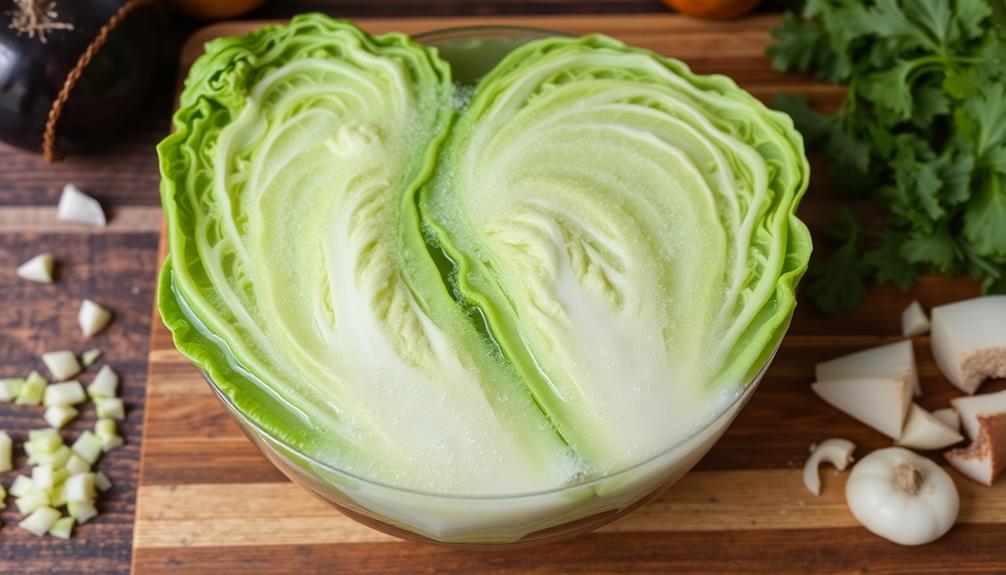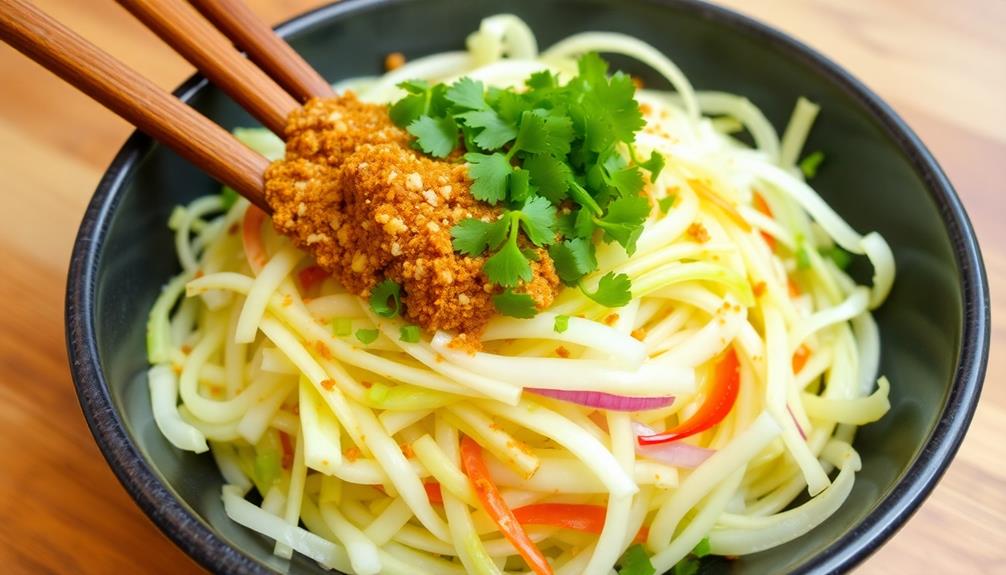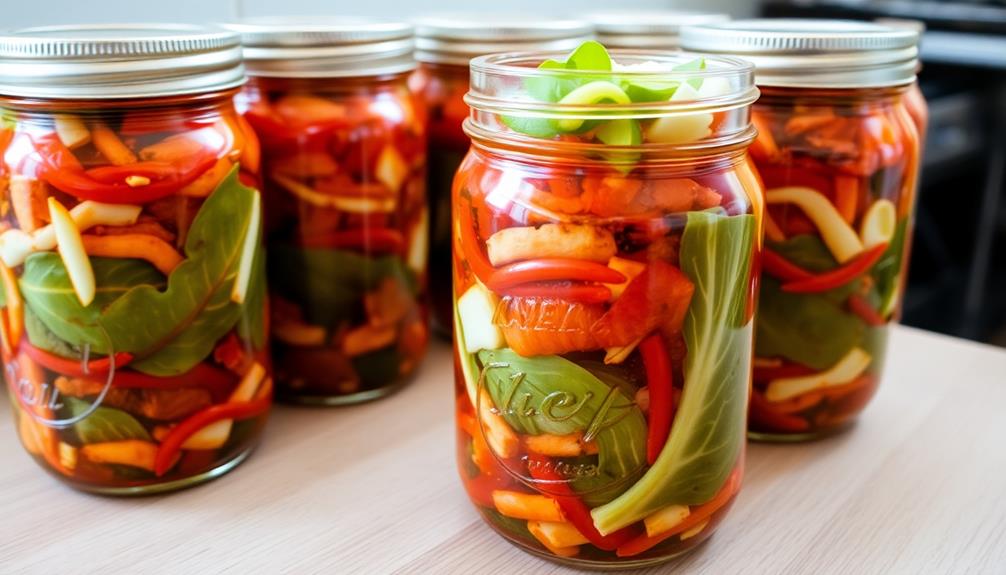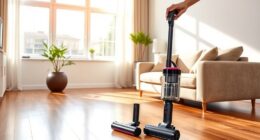Homemade kimchi offers a delectable way to explore Korean culinary heritage. This fermented cabbage dish boasts a rich history spanning centuries and can be customized to suit your tastes. To make it, you'll carefully chop Napa cabbage, rinse and soak it, then massage a spice paste of chili powder, garlic, ginger, fish sauce, and sugar into the veggies. Pack the kimchi into jars and let it ferment at room temperature for 3-7 days, monitoring the tanginess. Refrigerate the finished product, which will continue developing bold, spicy, and tangy flavors. Discover the art and science behind this probiotic-packed Korean staple.
Key Takeaways
- Gather essential ingredients like Napa cabbage, Korean red pepper flakes, garlic, ginger, and fish sauce for a customizable and flavorful homemade kimchi.
- Prepare the cabbage meticulously by chopping, rinsing, and squeezing out excess moisture to enhance flavor absorption during the fermentation process.
- Create a spice paste by combining chili powder, garlic, ginger, fish sauce, and sugar, then thoroughly massage it into the cabbage for optimal fermentation.
- Ferment the packed kimchi at room temperature for 3-7 days, adjusting the time based on desired tanginess, and then transfer it to the refrigerator for storage.
- Monitor the kimchi closely during fermentation, tasting it periodically to assess the tanginess and crunch level, and adjust the process accordingly.
History

Kimchi's origins trace back centuries, woven into the fabric of Korean culinary heritage. This fermented vegetable dish has evolved over time, with regional variations and family recipes passed down through generations. The earliest records of kimchi date back to the 3rd century, when salted and fermented vegetables were used to preserve food during the harsh Korean winters.
As the country's agricultural and culinary practices advanced, kimchi became a dietary staple, providing essential nutrients and probiotics.
Today, there are hundreds of kimchi varieties, each with its own unique flavor profile and preparation method. From the classic napa cabbage kimchi to radish, cucumber, and even seafood-based versions, this versatile dish remains a cornerstone of Korean cuisine.
The process of making kimchi, which involves chopping, salting, and fermenting the ingredients, is considered an art form, often passed down within families with great pride and attention to detail.
Recipe

Kimchi, the quintessential Korean fermented cabbage dish, is a vibrant, flavorful addition to any meal. This homemade version allows you to customize the spice level and ingredients to your taste, ensuring a truly authentic and satisfying experience.
The fermentation process not only infuses the kimchi with a complex, tangy flavor but also provides beneficial probiotics that support gut health. Preparing kimchi at home is a rewarding culinary adventure, allowing you to explore the rich cultural heritage of Korean cuisine.
Ingredients:
- 1 large head Napa cabbage, roughly chopped
- 1/2 cup coarse sea salt
- 1 cup water
- 1/2 cup Korean red pepper flakes (gochugaru)
- 3 tablespoons minced garlic
- 2 tablespoons minced ginger
- 1/2 cup Korean fish sauce
- 2 tablespoons white sugar
- 2 green onions, thinly sliced
- 1 carrot, julienned
Cooking Instructions:
In a large bowl, combine the chopped Napa cabbage and sea salt. Add the water, cover, and let sit for 2-3 hours, stirring occasionally, until the cabbage is wilted and has released its juices.
Drain the cabbage, reserving the liquid. In a separate bowl, mix the Korean red pepper flakes, garlic, ginger, fish sauce, and sugar until well combined. Add the drained cabbage and toss to coat evenly.
Pack the seasoned cabbage into a clean, airtight container, pressing down to remove any air pockets. Pour the reserved liquid over the top, ensuring the cabbage is fully submerged. Cover and let ferment at room temperature for 3-7 days, depending on your desired level of tanginess.
Once fermented, transfer the kimchi to the refrigerator, where it can be enjoyed for several months.
It's important to note that the fermentation process can be affected by factors such as temperature and humidity, so you may need to adjust the fermentation time to achieve your preferred flavor profile.
Additionally, feel free to experiment with the addition of other vegetables, such as radish, scallions, or even fruits, to create your own unique kimchi blend.
Cooking Steps

Chop up the napa cabbage into bite-sized pieces, then rinse and soak the cabbage in saltwater.
Once drained and squeezed dry, mix the spice paste thoroughly with the cabbage.
Step 1. Chop Napa Cabbage Into Bite-Sized Pieces

To begin with the chopping of the napa cabbage, first, you'll want to divide the large cabbage heads into manageable sections.
Take each section and gently peel off the outer leaves, discarding any damaged or discolored ones. Next, slice the cabbage in half lengthwise, then slice each half crosswise into 1-inch wide strips.
From here, you'll chop the strips into bite-sized pieces, about 1-inch square. Be sure to work quickly to avoid the leaves wilting. As you chop, you can place the prepared cabbage in a large bowl or pot, ready for the next steps in the kimchi-making process.
It's important to note that the size of the chopped cabbage pieces will affect the texture and mouthfeel of the final kimchi. Larger pieces will result in a chunkier, more substantial kimchi, while smaller pieces will create a finer, more delicate texture.
Choose the size that best suits your personal preferences.
Step 2. Rinse and Soak the Cabbage

After chopping the napa cabbage into bite-sized pieces, you'll need to rinse and soak the cabbage. This step helps to remove any dirt or debris and prepare the cabbage for the next stage of the kimchi-making process.
First, place the chopped cabbage in a large bowl and rinse it thoroughly under running water. Gently swish the cabbage around to ensure that all the surfaces are rinsed clean.
Next, fill the bowl with enough water to completely submerge the cabbage. Let the cabbage soak for 30 minutes to an hour. This soaking helps to soften the cabbage and draw out any remaining impurities.
After the soaking period, drain the cabbage well, making sure to remove as much excess water as possible. This will help the cabbage absorb the flavorful seasonings more effectively during the next step.
Now that the cabbage is clean and ready, you can move on to mixing the spices and seasonings that will transform it into delicious homemade kimchi. To start, gather ingredients like garlic, ginger, red pepper flakes, and fish sauce to create the flavorful paste. Adjust the spice levels to your liking, keeping in mind that a proper kimchi has a balance of heat, tang, and umami. While preparing the ingredients, you might also want to explore a *golden hash browns recipe* as a great companion side dish to add some crunch and variety to your meal! Once your spice paste is ready, thoroughly coat the cabbage, ensuring every leaf is generously covered for maximum flavor absorption. Allow the kimchi to ferment for a few days, letting its vibrant taste develop over time. While waiting, consider trying the golden hash browns recipe linked above for a crispy, savory addition to your table that perfectly complements the rich, spicy tang of the kimchi.
Step 3. Drain and Squeeze Cabbage Dry

Having drained the cabbage, gently squeeze out any remaining moisture. Removing excess liquid is crucial for achieving the proper texture and flavor in your kimchi.
Place the drained cabbage into a large, clean bowl. Using your hands, firmly press down on the cabbage, squeezing out as much water as possible. This step may take a few minutes, but it's important to be thorough.
Once the cabbage has been squeezed dry, you can move on to the next step. Discard the drained liquid, as it won't be needed for the rest of the recipe.
Be careful not to over-squeeze the cabbage, as you don't want to damage the leaves. The goal is to remove just enough moisture so that the seasoning can be evenly distributed and the fermentation process can begin properly.
With the cabbage now ready, you can proceed to mix in the flavorful kimchi paste.
Step 4. Mix Spice Paste With Cabbage

Now that you've squeezed the excess moisture from the cabbage, it's time to mix in the flavorful kimchi paste. In a large bowl, combine the Korean chili powder, minced garlic, grated ginger, fish sauce, and sugar. Stir these ingredients together until a thick, vibrant paste forms.
Next, add the squeezed cabbage to the spice paste. Using your hands, thoroughly mix the cabbage and paste together, ensuring each piece of cabbage is evenly coated. The paste should cling to the cabbage, creating a beautiful red hue throughout.
Once the cabbage and paste are fully incorporated, transfer the mixture to a large airtight container or jar. Press down on the kimchi to remove any air pockets, then seal the container.
Allow the kimchi to ferment at room temperature for 3-7 days, checking it periodically and pressing down on the mixture to release gases. Then, transfer the fermented kimchi to the refrigerator and enjoy its tangy, spicy, and crunchy goodness!
Step 5. Pack Kimchi Into Jars

With the cabbage and spice paste thoroughly mixed, it's time to pack the kimchi into airtight jars. This step is crucial for preserving the vibrant flavors and crunchy texture of your homemade kimchi.
Grab your clean, sterilized jars and start packing the kimchi in, pressing down firmly to remove any air pockets. Leave about an inch of headspace at the top of each jar to allow for expansion during fermentation.
Once the jars are packed, pour in the remaining brine from the mixing bowl, ensuring the cabbage is fully submerged. Seal the jars tightly, making sure there are no gaps that could allow air to enter.
Place the sealed jars in a cool, dark spot, like a pantry or cupboard, and let the kimchi ferment for 3-7 days, depending on your preferred tanginess.
Check the jars daily, releasing any built-up gas by briefly opening the lid.
After the fermentation period, transfer the jars to the refrigerator, where the kimchi will continue to develop its signature bold, spicy, and tangy flavors.
Final Thoughts

Crafting the perfect homemade kimchi is a rewarding journey, one that rewards patience and attention to detail.
As you've meticulously prepared the ingredients, massaged the cabbage, and packed the jars, the final step is to let your creation ferment to perfection.
Over the next few weeks, monitor your kimchi closely, tasting it periodically to ensure it reaches your desired level of tanginess and crunch.
When it's ready, transfer the jars to the refrigerator to slow the fermentation process and preserve your hard work.
Frequently Asked Questions
How Long Can Homemade Kimchi Be Stored?
Properly stored, your homemade kimchi can last up to 6 months in the refrigerator. The fermentation process helps preserve the flavors, but be sure to keep it properly sealed to prevent spoilage.
What Are the Health Benefits of Eating Kimchi?
Eating kimchi provides you with various health benefits. It's rich in probiotics that aid digestion, vitamins, and antioxidants that boost your immune system. Plus, it may help lower cholesterol and blood pressure levels, making it a nutritious addition to your diet.
Can I Customize the Flavor of My Kimchi?
Absolutely, you can customize the flavor of your kimchi! Feel free to experiment with different spices, vegetables, and even fruits to create your own unique taste. The possibilities are endless when you're making homemade kimchi.
How Do I Know if My Kimchi Has Gone Bad?
You'll know your kimchi has gone bad if it develops an off-odor, changes color, or becomes slimy. Look for signs of spoilage, and don't consume it if you're unsure – it's better to be safe than sorry.
Can I Use Different Vegetables for Homemade Kimchi?
You can absolutely use different vegetables for homemade kimchi! The possibilities are endless – try carrots, radishes, or even cabbage for a unique twist on the traditional recipe. Get creative and experiment with your favorite veggies.










